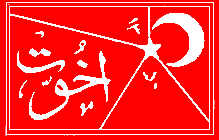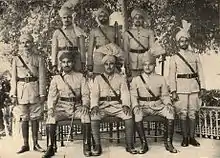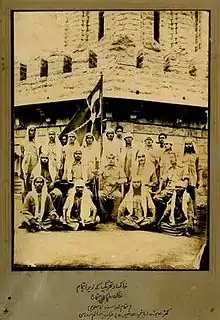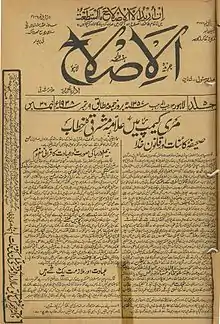Khaksar movement
The Khaksar movement (Urdu: تحریکِ خاکسار) was a social movement based in Lahore, Punjab, British India, established by Allama Mashriqi in 1931, with the aim of freeing India from the rule of the British Empire and establish a Hindu-Muslim government in India.[1] The membership of the Khaksar movement was open to everyone and had no membership fee regardless of the person's religion, race and caste or social status. The emphasis was on the brotherhood of mankind and being inclusive for all people.[2][3]

History


Around 1930,[lower-alpha 1] Allama Mashriqi, a charismatic Muslim intellectual whom some considered to be of anarchist persuasion,[5] revisited the principles for self-reform and self-conduct that he had laid out in his 1924 treatise, entitled Tazkira. He incorporated them into a second treatise, Isharat, and this served as the foundation for the Khaksar movement,[4] which Roy Jackson has described as being "... essentially to free India from colonial rule and to revive Islam, although it also aimed to give justice and equal rights to all faiths."[5] They took their name from the Persian words khak and sar, respectively meaning dust and life and roughly combined to translate as a "humble person".[5][2]
Adopting the language of revolution,[5] Mashriqi began recruiting followers to his cause in his village of Ichhra near Lahore. An early report said that the movement began with 90 followers. It quickly expanded, adding 300 young members within a few weeks.[4] By 1942 it was reported that the membership was four million and Jackson remarks that it was "phenomenal in its success."[5] There was also an associated weekly newspaper called Al-Islah.[3]
On 4 October 1939, after the commencement of the Second world war, Mashriqui, who was then in Lucknow jail, offered to increase the size of the organisation to help with the war effort. He offered a force of 30,000 well-drilled soldiers for the internal defence of India, 10,000 for the police, and 10,000 to provide help for Turkey or to fight on European soil. His offer was not accepted.
Due to the movement's rigid manifesto and strict policies to adhere to their own ideology, it often came into conflict with the ruling British government. Allama Mashriqi and some of his followers spent much time in British government's jails. Mashriqi was kept in jail without any legal proceedings. In protest, he had fasted to the point of death.[2] Mashraqi was released from Vellore Jail on 19 January 1942, but his movements were restricted to Madras Presidency. He remained interned until 28 December 1942. Mashraqi arrived in New Delhi on 2 January 1943.[6]
The Khaskar Movement was vocal in its opposition to the partition of India,[7][8][9] and instead favored a united India.[10] During the partition itself, the Khaksars took a vow to do what they could to protect those in distress; this resulted in many lives being saved, including Hindus, Sikhs and Muslims.[11] In one incident, a Khaksar volunteer entered a local colony near Rawalpindi to calm people down, but was stabbed to death.[11]
Allama Mashriqi disbanded the Khaksar Tehrik on 4 July 1947 considering that the Muslims of India were more than satisfied after the newly revived hope of a new separate Muslim state i.e. Pakistan and he felt that they had lost much of their motivation which could meet the requirements of the Khaksar movement. Khaksar movement's declared objectives of unity of India regardless of religion eventually came in conflict with All India Muslim League's and Muhammad Ali Jinnah's objectives of Two-nation theory based on the religions of Hindus and Muslims of British India. A significant number of the Indian Muslim population gravitated to the formation of a separate Muslim nation and thus helped create Pakistan in 1947.[2]
In October 1947, after the creation of Pakistan, Mashriqi founded the Islam League. Khaksar Tehrik was later revived as a civilian political group after his death on 27 August 1963 at Lahore and it sometimes made political alliances with other Pakistani political parties, for example, it joined the Pakistan National Alliance in 1977.[2][12]
Ideology

Twenty-Four Principles
Mashriqi had said in 1931 that the Khaksar movement had three distinct objectives; "to emphasize the idea of superiority of God, unity of the nation and service to mankind".[13] In addition, Mashriqi outlined twenty-four principles on 29 November 1936 in an address to a Khaksar camp at Sialkot.[14] This initial speech and subsequent set of principles laid out by the movement founder, encouraged members of the movement to serve the people regardless of their caste or religion; and Khaksars were expected to convince others to join the movement through "love and affection".[14][2]
Fourteen Points; The Khaksar Creed
On 14 March 1937, Allama Mashriqi again addressed a camp of Khaksars at Lahore to further clarify the fourteen points that became the foundation of the movement.[15] These points solidified the notion that the movement was both dictatorial and militaristic. In other words, the movement founder Allama Mashriqi was mainly shaping the policy guidelines. The organization was set up in a way where Allama Mashriqi was the Khaksar-e-Azam (the biggest khaksar) with an advisory council but Allama could overrule any advice. He was entitled to remove any movement member from the organization while there was no procedure to remove him. At this point, its aims were to establish self-rule in India. However the success of Muslim rule in India necessitated certain conditions, such as: "(a) "regard for the religious and social sentiments of the various communities that live in British India: (b) maintenance of their particular culture and customs, and (c) general tolerance".[16][2]
The volunteers of the Khaksar movement were expected to participate daily in military parade and social work. They were seen drilling and parading in playgrounds, streets and neighborhoods wearing khaki uniforms with spades on their shoulders. The movement workers were required to bear their own expenses and find spare time for work of social welfare in the community.[2]
Khaksar symbols
All members, regardless of rank, wore the same uniform; a khaki shirt with khaki pyjama secured with a belt, together with military boots. The khaki colour was chosen because it was "simple and unassuming" and "cheap and available for all", although in practice the uniforms were paid for by the Khaksar organisation. They wore a red badge (akhuwat) on their right arm as a symbol of brotherhood. On their heads Khaksars wore the white handkerchief of the Arabs and Hajis, consisting of a white cloth the length and width of one and one-half yards which was secured around the head with a cotton string.[17] Some Khaksar's wore the Pashtun style turban on their head with the cloth flowing down and a fan shaped shamla peaking up.
All Khaksars carried a bailcha (spade) as a sign of unity and strength.[18] In addition the spade represents humility, in the same way that a spade is used to level the ground, the Khaksars used it as a symbol of the "leveling" of society. In other words, it was meant to be used to level the existing society for equity and equality and remove the existing division among the rich and the poor.[2]
The flag of the Khaksars is a modified Ottoman symbol; a crescent moon and a star on a red background.[19]
References
Notes
Citations
- De, Amalendu (2009). History of the Khaksar Movement in India, 1931–1947. Kolkata: Parul Prakashani. pp. 71–72.
- Profile of The Khaksar Movement on storyofpakistan.com website Retrieved 19 January 2018
- Nasim Yousaf (24 August 2016). "The 'Belcha': Allama Mashriqi's powerful symbol for the Khaksar Tehrik". TwoCircles.net website. Retrieved 20 January 2018.
- De, Amalendu (2009). History of the Khaksar Movement in India, 1931–1947. Kolkata: Parul Prakashani. pp. 72–73.
- Jackson, Roy (2011). Mawlana Mawdudi and Political Islam: Authority and the Islamic State. Taylor & Francis. p. 60. ISBN 978-0-415-47411-5. Retrieved 19 January 2018.
- Syed Shabbir Hussain, Al-Mashriqi: The Disowned Genius, 1991, page 180, Publisher: Jang Publisher, Lahore, Pakistan.
- Malik, Muhammad Aslam (2000). Allama Inayatullah Mashraqi: A Political Biography. Oxford University Press. p. 131. ISBN 9780195791587.
The resolution was a bad omen to all those parties, including the Khaksars, which were, in one way or the other, opposing the partition of the subcontinent.
- Talbot, Ian (2013). Khizr Tiwana, the Punjab Unionist Party and the Partition of India. Routledge. ISBN 9781136790294.
He also enlisted the support of the Khaksars“ who had been bitter opponents of Sikander." They, nevertheless possessed the virtue of being outspoken critics of the Pakistan scheme.
- Paracha, Nadeem F. (11 May 2014). https://www.dawn.com/news/1105473.
Confessional religious parties like the Jamiat-i-Ulema-i-Hind (JUH), and radical right-wing outfits such as the Majlis-i-Ahrar and the Khaksar Movement were staunchly against the concept of ‘Muslim Nationalism’ being propagated by Jinnah and his party.
Missing or empty|title=(help) - Husain, Zakir (1985). Communal Harmony and the Future of India: The Study of the Role and Thoughts of Nation Builders for India's Unity, 1857-1985. Prakash Book Depot. p. 147.
The Khaksar movement, the Red Shirt movement, the Ahrar movement and many other organisations of that ilk are the examples of Muslim genuineness in the unity and integrity of India.
- Pal, Sanchari (12 September 2016). "Unknown and Unsung, They Saved Hundreds of Lives During Partition but Were Never Celebrated". The Better India.
- Nazir Hussein Siyal (27 August 2016). "Nation still needs a dauntless leader like Allama Mashriqi: Khaksar Tehrik chief". Daily Times (newspaper). Retrieved 20 January 2018.
- De, Amalendu (2009). History of the Khaksar Movement in India, 1931–1947. Kolkata: Parul Prakashani. p. 126.
- De, Amalendu (2009). History of the Khaksar Movement in India, 1931–1947. Kolkata: Parul Prakashani. p. 127.
- De, Amalendu (2009). History of the Khaksar Movement in India, 1931–1947. Kolkata: Parul Prakashani. p. 128.
- De, Amalendu (2009). History of the Khaksar Movement in India, 1931–1947. Kolkata: Parul Prakashani. pp. 130–131.
- De, Amalendu (2009). History of the Khaksar Movement in India, 1931–1947. Kolkata: Parul Prakashani. pp. 166–167.
- De, Amalendu (2009). History of the Khaksar Movement in India, 1931–1947. Kolkata: Parul Prakashani. pp. 151–154.
- De, Amalendu (2009). History of the Khaksar Movement in India, 1931–1947. Kolkata: Parul Prakashani. p. 165.
External links
Further reading
- Daechsel, Markus (2006). The Politics of Self-Expression: The Urdu Middleclass Milieu in Mid-Twentieth Century India and Pakistan. Routledge. ISBN 978-1-13438-371-9.
